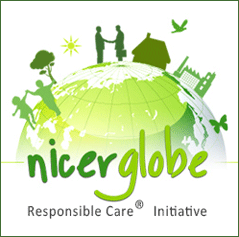


- Anil M. Sardhara and Bhaskar N. Thorat*
STEVIA
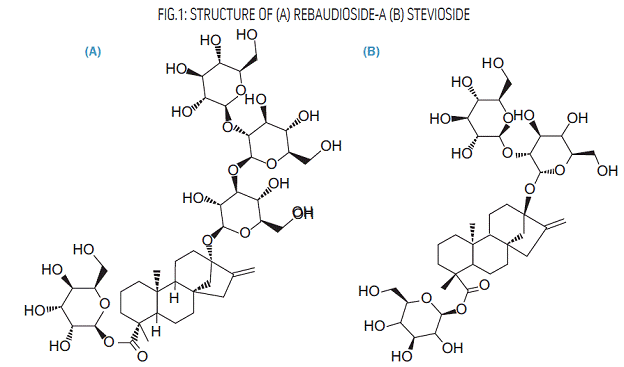 The plant Stevia which has been used for centuries by the indigenous Guarani natives as a traditional sweetener (for herbal, teas and other beverages) belongs to the Asteraceae family, tribe Eupatoriae. It comprises approximately 150-200 species of perennial herbs and shrubs, growing mostly at altitudes of 500-3000 m in semidry mountains. During cultivation on more fertile soils, the mature plant can go up to 1.8 min height. The species can also grow in grasslands, scrub forests and sub-alpine areas. The plant Stevia is indigenous to the northern regions of South America and grows wild in the highlands of Amambay and near the source of the river Monday (a border area between Brazil and Paraguay). This is a small bush used by the Paraguayan Indians for hundreds of years as a sweetener in their powerful drink, or as a medicine. Since it is a wild bush growing in the mountains, it took a relatively long time to be "discovered" and described by a bonafide botanist, Moises S. Bertoni, an Italian scientist, the director of the College of Agriculture in Asuncion, Paraguay. By1905, he had it described and named after the chemist who first refined it, Dr. Rebaudi. Stevia rebaudiana is entirely a new worldgenus, its distribution ranging from southern United States and north eastern Paraguay to southeastern Brazil through Mexico, Central America, the Southern American Andes and the Brazilian highlands (Soejarto et al., 1983). This plant is gaining significance and is expected to develop into a major source of high potency sweetener for the growing natural food market. This plant is totally innocuous, posing no threat to human life and health, holding out in fact great hope of the production of a non-calorie sweetener with health benefits.
The plant Stevia which has been used for centuries by the indigenous Guarani natives as a traditional sweetener (for herbal, teas and other beverages) belongs to the Asteraceae family, tribe Eupatoriae. It comprises approximately 150-200 species of perennial herbs and shrubs, growing mostly at altitudes of 500-3000 m in semidry mountains. During cultivation on more fertile soils, the mature plant can go up to 1.8 min height. The species can also grow in grasslands, scrub forests and sub-alpine areas. The plant Stevia is indigenous to the northern regions of South America and grows wild in the highlands of Amambay and near the source of the river Monday (a border area between Brazil and Paraguay). This is a small bush used by the Paraguayan Indians for hundreds of years as a sweetener in their powerful drink, or as a medicine. Since it is a wild bush growing in the mountains, it took a relatively long time to be "discovered" and described by a bonafide botanist, Moises S. Bertoni, an Italian scientist, the director of the College of Agriculture in Asuncion, Paraguay. By1905, he had it described and named after the chemist who first refined it, Dr. Rebaudi. Stevia rebaudiana is entirely a new worldgenus, its distribution ranging from southern United States and north eastern Paraguay to southeastern Brazil through Mexico, Central America, the Southern American Andes and the Brazilian highlands (Soejarto et al., 1983). This plant is gaining significance and is expected to develop into a major source of high potency sweetener for the growing natural food market. This plant is totally innocuous, posing no threat to human life and health, holding out in fact great hope of the production of a non-calorie sweetener with health benefits.
The leaves of S. rebaudiana accumulate sweet-tasting diterpene glycosides, known as steviol glycosides, the concentrations of which vary quite widely depending on the genotype and production environment. Steviolglycosides are stevioside, Steviolbioside, Rebaudioside A, B, C, D, E, F and Dulcoside. Stevia is the common name for the extract stevioside from the leaves of S. rebaudiana Bertoni. Stevioside was reported to be the most abundant stevia glycoside (4-13% w/w) found in the plant leaves. It is followed by Rebaudioside A (2-4% w/w), Rebaudioside C (1-2% w/w) and Dulcoside A (0.4-0.7% w/w) (Mondaca et al., 2012). Steviolbioside, Rebaudioside B, D, E and F were also identified in the leaf extracts, but as minor constituents. Steviol glycosides are diterpene glycosides which contain glucose molecules attached to an aglycone steviol moiety. All steviol glycosides have same chemical structures which only differ in substitution of sugar moiety at C13 and C19. The common structure of steviol glycosides are as shown in Figure 1.

In addition to sweetening foods, Stevia extracts can increase the palatability and attractiveness (enjoyment) of food through enhancement of flavours and odours. One teaspoon of stevioside or liquid equals one cup of sugar. An eighth of a teaspoon will sweeten a mug of unsweetened hot cocoa just as well or better than a tablespoon of sugar or many packets of chemical sweeteners. Other studies have shown stevioside to be non-fermentative and it does not form plaque on your teeth or feed bacteria that cause dental caries. It has no calories (zero glycemicindex), has not harmed any animals in laboratory tests, and does not break down when heated.
Beside these sweet compounds, stevia extract also contain some other nutritional component such as carbohydrate, lipids, protein, minerals and vitamins. Due to which Stevia also provide additional therapeutic activities. Detail about this entire nutritional aspect is given in Table 2.

The Stevia plant and stevioside have been used in the treatment of cancer and as substitutes for saccharose in the treatment of diabetes, obesity and hypertension. They can also act as an anti-cariogenic product and as anti- gingivitis. Number of studies have suggested that, besides sweetness, stevioside, along with related compounds that include rebaudioside A, steviol and isosteviol, may also offer therapeutic benefits, as they have anti-hyperglycaemic, anti-hypertensive, anti-inflammatory, anti-tumour, anti-diarrhoeal, diuretic, and immunomodulatory effects. High potassium ion (K+) level produces diuretic effect. Currently, there is a popular use of herbal and alternative medicine for the treatment of diabetes. Indeed, extract from S. rebaudiana has long been used for the treatment of diabetes in South America (Kinghorn & Soejarto, 2002). Stevioside at a high dose (5 mM) has no inhibitory effect on glucose absorption. However, 1 mM steviol inhibits glucose absorption by about 40%. Stevioside and steviol also induces insulin secretion from the β cells of langerhans islets. In addition, stevioside, the major component of the extract, has a high sweetness with no calorie and only a small amount is needed for sweetening purposes. Thus, it should be a good alternative to sugar for diabetic patients.
TOXICOLOGY STUDY
The toxicology of stevioside has been extensively studied, and related data, reassessed lately, indicated it to be non-toxic, non mutagenic, and non-carcinogenic. It was also clearly demonstrated that high concentrations of the sweetener rebaudioside A, administered in the diet of rats over 90 days, were not associated with any signs of toxicity (Gardana et al., 2010) and no allergic reaction have been observed when it is used as a sweetener (Abou-Arabet al., 2010). A number of studies have demonstrated that oral intake of stevioside has no effect on fertility, neither in mice (Akashi& Yokoyama, 1975), nor in rats (Mori et al., 1981; Xili et al., 1992), nor in hamsters (Yodyingyuad & Bunyawong, 1991). Adverse effects of stevia have not really been observed. Its commercialization, in France for example, as a food or a food ingredient has been prohibited based mainly on economical arguments and not on proven adverse health effects (Serio, 2010).
However, it is thought that stevia could provoke allergic reactions in people sensitive to plants of the Asteraceae family and it is also recommended that pregnant women should avoid consuming stevia (Serio, 2010).
SAFETY APPROVAL FROM DIFFERENT REGULATORY AUTHORITIES
Japan has been using stevia extracts for more than 30 years. In 2008, the U.S. Food and Drug Administration (FDA) issued GRAS (Generally Recognized as Safe) notice for Reb A sweetener use in food products. Numerous studies have shown that Reb A, unlike sugar, does not affect blood glucose or insulin levels.
In June 2008, the Joint Expert Committee on Food Additives ("JECFA"), administered jointly by the United Nations' World Health Organization (WHO) and the Food and Agricultural Organization (FAO), raised the acceptable daily intake level for stevia. JECFA published its approval of stevia after a decade of study, stating that, "95% steviol glycosides are safe for human use in the range of four milligrams per kilogram of body weight per day". This doubled the average daily intake level previously set by JECFA from earlier studies.
The European Food Safety Agency (EFSA) also approved Reb A as a food and beverage ingredient early in 2011; and it was approved for general consumption near the end of 2011. Reb A had already been approved for use in France under an associated review process. Retail products sweetened with RebA are readily available there. Then, in July 2011 Food and Agriculture Organization (FAO) and the World Health Organization (WHO) food standards program, the Codex Alimentarius Commission, published guidance on Reb A usage levels in common foodstuffs, further confirming acceptance of its safety. The Codex guidelines generally set the standard for the world.
STEVIA GLOBAL MARKET
The global sweetener market is a $60 billion industry split into three categories: sugar (82%), high fructose corn syrup HFCS (9%), and high intensity sweeteners HIS (9%).The share of high intensity sweeteners is not significant in the global sweeteners market, but their shares are expected to rise in the coming years, due to increased awareness and usage of dietary foods and increasing cases of obesity, diabetes, and growing health concerns among the people. The overall sweetener market is growing but HFCS and HIS ingredients are being replaced with natural zero calorie alternatives such as stevia. Stevia is the fastest growing product in the alternative sweetener sector and the World Health Organization expects stevia to eventually replace 20% of the sugar segment or a $10 billion opportunity. Within its first year of launch in the US, stevia surpassed the market share of Aspartame and Saccharine in the HIS market. In addition, stevia is being blended with sugar to meet the low calorie consumer requirements while still maintaining all natural sweetener ingredients, functionality and taste.
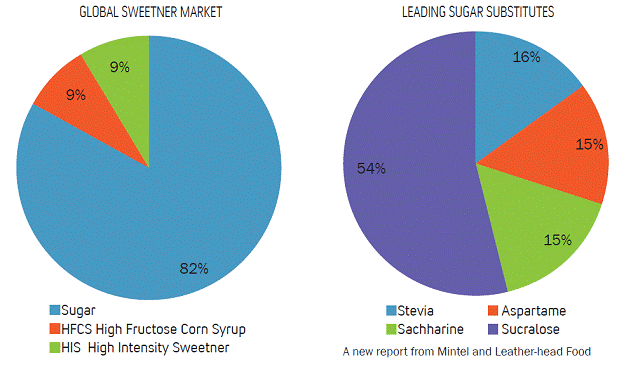
Stevia has enjoyed a rapid rise in popularity globally over the past four years with products launched across 35 countries in 2010. Within two years of its US market introduction, Nielsen retail consumption data indicated almost $2 billion of stevia-related retail sales until year 2012. Asia Pacific has the highest market share of stevia extracts at 36%, followed by North American with 30% and South America with 24%.
Zenith International estimates worldwide sales of stevia extract reached 3,500 tons in 2010 with an overall market value of $285mm and is forecasting that the global market for stevia will reach 11,000 tons by 2014 requiring the tripling of stevia leaf production at the farm level to keep pace with consumer demand.
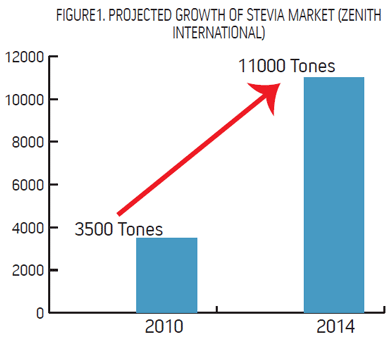
Research stated in 2009, only 5% of food and drink products launched using intense sweeteners used solely plant derived sweeteners (although a further 2% used a blend of artificial and plant derived sweeteners). In contrast, in 2013, the share of plant-derived sweeteners jumped to 15% (with a further 3% used a blend of artificial and plant derived sweeteners). Between 2011 and 2013, plant-derived sweeteners reached a high of 28% of launches in North America (Laura J., 2014).
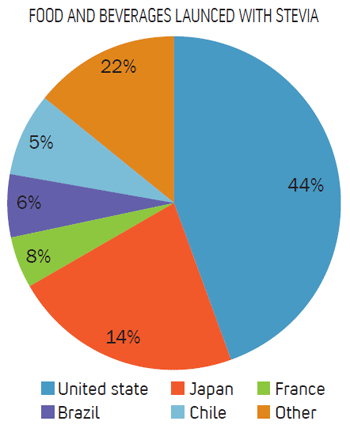
Feed additives are a $15 billion market and provide an important value addition to the vertically integrated downstream market. Global consumer awareness has brought about the rise in demand of healthy and safe animal derived food which sparked a complete ban on antibiotic usage as growth promoters in the European Union in 2006 and the US in 2009 creating a huge demand for safe natural feed additives that improve the growth rate and health of animals. This introduces an additional market for stevia extracts and also provides a market for the complete plant including the leaf and the stem. The competitive landscape is open with no major company establishing a line of stevia feed additives to date.
CHALLENGES AND APPROACHES FOR SOLUTION
The initial enthusiasm for the ingredient came from its highly attractive attributes - natural (it's from a leaf!), nonnutritive, intensely sweet, and with acceptable taste, at least at first glance. But it wore thin as it became apparent that the ingredient couldn't just be chucked in to replace sugar in most situations with any reasonable hope of success. Sugar just tastes good in everything, and not a lot of formulation brainpower is needed to make it work in a wide variety of applications.Not so with stevia. It's sweetness peak might be only fractions of a second past that of sugar on the tongue, but the tongue is a remarkably sensitive organ, adapted to taste things fast enough so that they can be spit out before the tongue's owner poisoned herself. So those fractions of a second mattered. The end of the sweetness profile also mattered with stevia, at least in its initial formulations, displaying a lingering note described as metallic or licorice-like. All in all, while the ingredient was perceived as sweet, to most tasters it was definitely NOT sugar.
"When stevia leaf extract first achieved GRAS status in the US, formulators used stevia leaf extract in less challenging applications such as flavored waters, with great marketplace acceptance. At that time, formulators discovered that using sweetness enhancers and flavor maskers, or other sweeteners like erythritol, was the best way to round out the flavor profile," David Henstrom, vice president of health ingredients at Cargill toldFoodNavigator-USA.
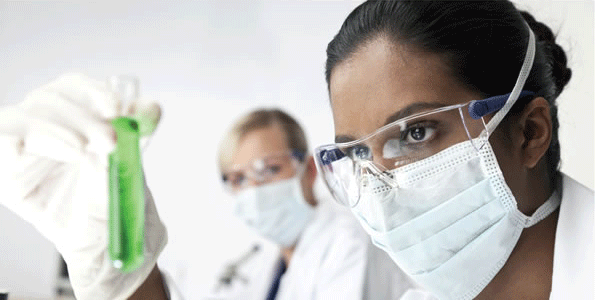
Then researchers started to discover which of the glycosides in the leaf contributed themost to sweet taste and have minimum the bitterness. As result of this hunt, Rebaudioside A became the first successful and most widelyadopted of the standalone glycosides."Based on the publicly traded information, 80% or 90% of the stevia that is sold is pure Reb A," said Paul Paslaski, vice president of sales at monk fruit supplier Biovittoria who had experience with stevia during a prior stint with Cargill. But Reb A also had its drawbacks; although Reb A is a really important part of our stevia portfolio, it didn't work in every application. Other stevia glycosides (Reb D and Reb-X) plus blends of different glycosides are used to optimize product taste profiles and achieve deeper calorie reductions. Therefore,product developers continued to work with different formulation strategies to try to work around them.The newer blends appeared to work better in a calorie reduction scenario, while the standalone glycosides, especially some of the newer glycosides, performed well in a straight diet product matrix. There are definitely two approaches developing and they can be seen it in the marketplace. Some people aregoing with compositions or blends, and some people are sticking with single glycosides.
PureCircle and Sweet Green Fields tried another way and took approach of traditional plant breeding to raise the level of Reb A in the leaf and also to raise the total glycoside content in theleaf. So the market comes to another division, and that is between what seems more comfortably natural -ingredients derived from plant source material - to technologies that take several steps beyond that.
But even with the progress that has been made on the plant breeding front; some companies like Cargill and California-based startup Stevia First believe that fermentation of certain hard-to-obtain steviol glycosides will be the commercially viable answer going forward.They believe fermentation may be a more cost-effective solution long-term forobtaining the best-tasting minor steviol glycosides.
The authors believe that 'stevia' is at the crossroads as being accepted as a natural product, either as crude extract or as a Reb A rich stevioside. The fermentation route is quite possible to obtain the minor steviol Glycosides as secondary metabolites, the same way beer, wine and scores of antibiotics are produced naturally.(Note: Institute of chemical technology has developed aqueous extraction followed by fractional crystallization to obtain Reb A in excess of 90% w/w).
AUTHORS:
ANIL M. SARDHARA AND BHASKAR N.THORAT*
Advance Drying Laboratory, Department of Chemical Engineering, Institute of Chemical Technology, Matunga (E), Mumbai - 400 019 *
Email address: thoratbn@gmail.com, bn.thorat@ictmumbai.edu.in

